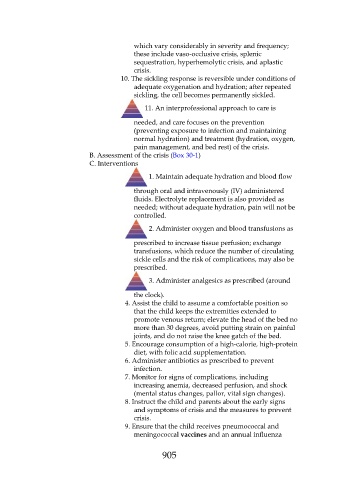Page 905 - Saunders Comprehensive Review For NCLEX-RN
P. 905
which vary considerably in severity and frequency;
these include vaso-occlusive crisis, splenic
sequestration, hyperhemolytic crisis, and aplastic
crisis.
10. The sickling response is reversible under conditions of
adequate oxygenation and hydration; after repeated
sickling, the cell becomes permanently sickled.
11. An interprofessional approach to care is
needed, and care focuses on the prevention
(preventing exposure to infection and maintaining
normal hydration) and treatment (hydration, oxygen,
pain management, and bed rest) of the crisis.
B. Assessment of the crisis (Box 30-1)
C. Interventions
1. Maintain adequate hydration and blood flow
through oral and intravenously (IV) administered
fluids. Electrolyte replacement is also provided as
needed; without adequate hydration, pain will not be
controlled.
2. Administer oxygen and blood transfusions as
prescribed to increase tissue perfusion; exchange
transfusions, which reduce the number of circulating
sickle cells and the risk of complications, may also be
prescribed.
3. Administer analgesics as prescribed (around
the clock).
4. Assist the child to assume a comfortable position so
that the child keeps the extremities extended to
promote venous return; elevate the head of the bed no
more than 30 degrees, avoid putting strain on painful
joints, and do not raise the knee gatch of the bed.
5. Encourage consumption of a high-calorie, high-protein
diet, with folic acid supplementation.
6. Administer antibiotics as prescribed to prevent
infection.
7. Monitor for signs of complications, including
increasing anemia, decreased perfusion, and shock
(mental status changes, pallor, vital sign changes).
8. Instruct the child and parents about the early signs
and symptoms of crisis and the measures to prevent
crisis.
9. Ensure that the child receives pneumococcal and
meningococcal vaccines and an annual influenza
905

